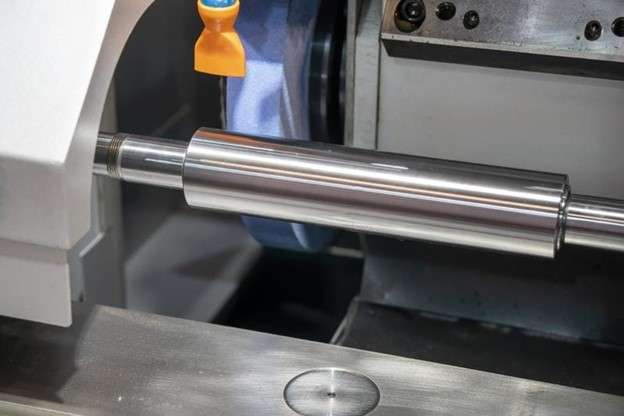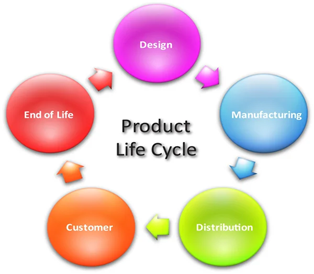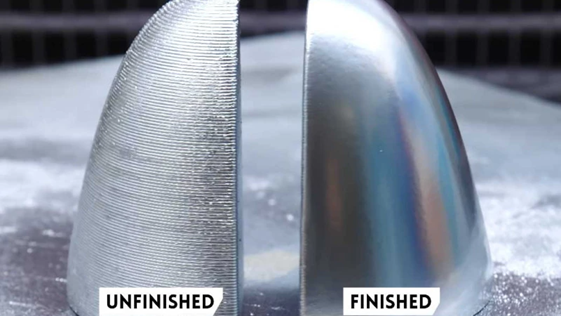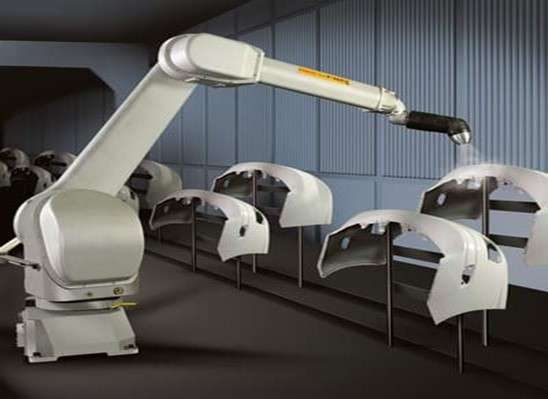
A finished steel surface
Surface finishing is an essential process in manufacturing almost every part or product. Different finishing approaches are used in the post-processing stage of manufacturing items depending on the material type, intended use, and functionality.
Regardless of the manufacturing approach used in creating parts, various surface finishing procedures are employed to enhance the performance, appearance, and product life. This article will briefly discuss the role or importance of surface finishing in a product’s life.
What is meant by Surface Finishing?
Surface finishing or treatment is a process of treating the surface of a material to improve its appearance, durability, or surface properties. The strategy aims to improve a material’s surface quality and functional properties. It can include removing defects or rough spots, increasing surface hardness or wear resistance, changing the surface texture or appearance, or providing corrosion protection.
There are different surface treatment techniques for a diverse range of parts or products, depending on the specific requirements of the material and its intended application.
- Grinding
- Honing
- Lapping
- Sandblasting
- Electroplating
- Anodizing
- Painting
- Coating, and more.
What is meant by Product Life in Manufacturing?

Product life-cycle
Product life refers to the period during which a product is considered useful, functional, and commercially viable. In manufacturing, it is the entire time from the product’s development and production to its eventual retirement from the market.
Generally, product life includes all the stages of manufacturing, from conceptualization, design, and prototyping, along with the time of manufacture to the point at which it is no longer functioning. However, from the customer perspective, product life is a timeframe within which it can be used for the intended application effectively and efficiently.
Here are some key points that elaborate on the importance of product life in manufacturing:
- Brand or business reputation: Product life positively or negatively affect the company’s reputation. Products with a long lifespan can help build brand credibility and customer trust, while products with a short lifespan can hurt a company’s reputation and reduce customer loyalty.
- Customer satisfaction: Customers expect products to last for a reasonable time. Products with longer lifespans become more convenient and reliable, providing better money value to the customer. Therefore, the customer will be satisfied with a product that meets or exceeds their expectations.
- Reduce the overall product costs: Manufacturers can save money by producing products with longer lifespans, as they will require fewer repairs and replacements, which can lower warranty and customer service costs.
- Sustainability: Products with longer lifespans are often more environmentally friendly and contribute to sustainability efforts. It can help companies to reduce their carbon footprint and meet customer demands for sustainable products.
- Repeat business: Customers are more likely to repeat business with a company that offers parts or products with longer lifespans, as they are more satisfied with the value they receive. It can result in increased revenue and profitability for the company.
Three Major Advantages of Surface Finishing

Before and after the surface finish
As this article mentioned, Metal surface finishing improves functionality, aesthetics, and product longevity. We will discuss each of them in detail since all three advantages of surface finishing ultimately contribute to the overall lifespan of any manufactured product.
Enhanced functionality and usability
Surface finishing can significantly enhance the functionality of a product by providing improved grip, durability, and performance. For example, certain types of surface finishes can improve the product’s performance by reducing friction and improving heat dissipation. For instance, Coatings are widely used for metal cutting tools to enhance their wear resistance and performance. About 80% of cemented carbide cutting inserts are coated with a wear-resistant hard material coating (Leiden, 2020).
It is essential for manufacturers to carefully consider the impact of surface finishing on a product’s functionality and usability while choosing the appropriate finishing techniques to meet their specific requirements.
Improved aesthetics and marketability
Surface finishing has a significant impact on the aesthetics and marketability of a product. A well-finished product looks more attractive and increases its perceived value, making it more appealing to potential customers. Additionally, some surface finishes, such as electroplating, can add a metallic or reflective finish, giving the product a premium and high-quality look.
Improved durability and longevity
A well-finished surface can protect the product from wear and tear and environmental factors such as moisture, heat, and corrosion. It improves the product’s lifespan and reduces the need for repairs and replacements, saving time and money.
For example, a hard anodized surface finish on aluminum parts can provide excellent resistance to wear and corrosion, making it ideal for use in harsh environments. Similarly, a smooth surface finish on moving parts can reduce friction, leading to a longer lifespan and improved performance.
How Does Surface Finishing Improve the Product Life?
Following are the 7 points to elaborate on how surface finishing improves the product life.
1. It smooths the rough edges
When metal or plastic parts are machined, cast, or molded, they often leave rough edges and surface irregularities. These rough spots can create stress concentrations that cause cracks over time, leading to several problems, including product failure. By removing these rough areas, surface finishing helps to create a smoother surface that is less vulnerable to stress concentrations.
The stress concentrations caused by rough edges are particularly problematic in products subject to cyclic loadings, such as those in moving machinery. As a result of the repetitive stress and strain, cracks may start to appear and spread over time, resulting in product failure. Surface finishing lessens the possibility of stress concentrations, which lowers the chance of fractures developing and distributing.
2. Reduce friction & improve lubricity
Friction between moving parts can cause wear and tear over time, especially in products subject to frequent use or high loads, such as machinery, vehicles, and electrical components. The repeated friction between moving parts results in surface wear and damage.
Surface finishing helps to reduce friction by creating a smoother surface that reduces the resistance to motion. It helps to extend the product’s life by reducing wear and tear, reducing the need for frequent replacement and maintenance, and improving performance.
In addition to reducing friction, the surface finish also improves the lubricity of the product, reducing friction even further and improving performance. This can lead to a longer product life and improved performance, making the product more attractive to customers.
Corrosion is the main problem behind the function life of any product. It degrades the material and ultimately reduces the overall lifespan. Many products are exposed to corrosive environments, such as moisture, salt, or chemicals, which can cause corrosion and degradation over time. This can lead to product failure and a reduced life span, especially in products subject to repeated exposure to corrosive conditions.
Surface finishing helps to increase corrosion resistance by removing contaminants and creating a uniform, smooth surface that is less prone to corrosion. In fact, the protective layer on the surface reduces the corrosion rate, contributing to the long product life.
4. It enhances surface hardness
Surface finishing operations not only improve the roughness but also improve the surface hardness with a hard coating layer. It can be achieved through hardening, heat treatment, or electroplating, which alters the microstructure of the surface to create a more rigid, wear-resistant surface.
Heat treatment is one of the most common methods for metal hardening, you can check this article below for more information, if not, please continue reading.
Furthermore, improving surface hardness extends the product’s life by reducing the wear and tear rate, lowering the need for frequent replacement and maintenance, and improving performance. This can also reduce costs over time, as the product will last longer and perform better.
5. It improves dimensional accuracy
Dimensional accuracy is critical for many products, especially those that require precise fitting and alignment, such as machinery or electrical components. Inaccurate dimensions can cause problems such as misalignment, increased friction, and reduced performance, leading to product failure over time.
Surface finishing can help to improve dimensional accuracy by removing contaminants and surface irregularities that can cause deviation from the desired dimensions. Especially those that require precise fitting and alignment, such as machinery or electrical components.
How to Choose the Right Surface Finishing Approach?

Automation in surface finishing.
Choosing the right surface finishing approach depends on many factors, including the material being finished, the desired outcome, and the requirements of the end product. Accurate surface finish specification is vital for extracting maximum functionality and durability (Mechanical treatment, n.d.).
Here are the chronological steps involved in the process of choosing the right surface finishing approach:
- Identify the desired outcome: The first step is determining the desired outcome of the surface finishing process. This may include improving the appearance of the surface, increasing its hardness, or reducing friction. So based on these, fixed the desired level of surface roughness, Ra value.
- Assess the requirements of the end product: It is crucial to consider the needs of the end product when choosing a surface finishing approach. For example, electroplating with a protective layer of zinc or nickel will be better for marine applications as it is known for its excellent corrosion resistance to water or salt.
- Review available techniques: Once the desired outcome and requirements of the end product have been determined, it is time to review the available methods for surface finishing based on your material type. It is essential to consider the cost, time, and skill level required for each technique and any potential drawbacks.
- Evaluate the suitability of each technique: Evaluate each available approach to determine which is the most suitable for the specific material, desired outcome, and end product requirements. This may involve conducting trial runs or testing the effectiveness of each technique.
- Make a decision: Once the evaluation is complete, decide on the most suitable surface finishing approach. This may involve choosing a single technique or combining several methods to achieve the desired outcome.
Conclusion
Surface finishing is a crucial aspect of the manufacturing process of almost all products. It enhances the product’s functionality, appearance, and longevity by removing rough spots, improving surface hardness & wear resistance, changing the surface texture or appearance, and providing corrosion protection. Therefore, it is vital to apply surface finishing for manufactured products.
ProleanTech is an on-demand manufacturing company that offers quality surface finishing service for metallic and non-metallic parts. We have experienced engineers and cutting-edge surface finishing technologies to meet your expectations. Please feel free to ask any questions, or get a quote from us.
FAQ’s
What is meant by product life in manufacturing?
In manufacturing, Product life refers to the period of usefulness, functionality, and commercial viability of a product, from development to retirement. It’s the time frame in which a product can be effectively and efficiently used for its intended purpose, as viewed by the customer.
How product’s life and surface finishing are correlated?
Product life and surface finishing are closely related, as the surface finishing of a product can significantly affect its longevity and overall performance. A well-finished surface protects it from various environmental factors that can cause wear and tear. On the other hand, a poorly finished surface can result in premature aging and decreased functionality of a product, shortening its life span.
How does product life affect customer satisfaction?
Products with longer lifespans become more convenient and reliable, providing better value to the customer. Therefore, the customer will be satisfied with a product that meets or exceeds their expectations.
References
- Leiden, A. (2020). Transferring life cycle engineering to surface engineering. Procedia CIRP.
- Mechanical treatment. (n.d.). Retrieved from Australian Stainless Steel Development Assoc.: https://www.assda.asn.au/stainless-steel/surface-finishes/mechanical-treatment




0 Comments
Trackbacks/Pingbacks